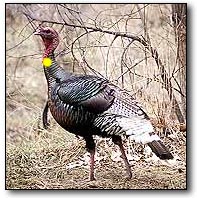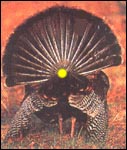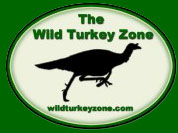|
Make
Every Shot Count
Some tips for reducing
misses and wounded birds
--by Rob Ramsdale--
Aiming
Points
This may seem like a
simple thing to most veteran hunters, but the aiming
point on a wild turkey is critical, especially for
those bowhunters out there. For shotgun hunters, there
are really only a few basic rules to follow:

- Aim for his neck - The
most lethal hit on a turkey is to his brain and
spinal cord. Direct hits in these two areas will
drop a turkey on the spot. Knowing this, the ideal
shot on a turkey is at the middle of his neck where
the skin stops and the feathers begin. By aiming
here instead of straight at his head, there is a
larger margin of error for a high shot and a low
shot will still hit the base of the neck. Also,
his head bobs and weaves a lot. If you aim at his
head and the bird is in close you can miss it completely
if its head moves. I generally aim even a little
lower on his neck when the bird is in close to make
sure I get a lethal hit. Yes, this may put a few
pellets in the breast meat but it's better than
missing or wounding a bird.
- Don't shoot a strutting bird.
-- If possible, let the bird either naturally stand
up and stretch his neck out or else cluck to the
bird and force him to stop strutting and stand up
straight to see what's making those clucks. A strutting
turkey has its neck folded back onto itself. By
standing and stretching his neck, the turkey presents
a larger target of his vital area, the spinal cord
(neck) and head. A larger target means you will
miss less often.
- Pattern Your Gun -- Many
guns shoot a pattern that is not centered with the
sights. The pattern is either high, low, left or
right of the point-of-aim or sometimes a combination
of these such as low and left. You can adjust for
this by using aftermarket sights or scopes that
will allow you to get your gun shooting where you
are aiming. Another important thing to find out
is your pattern density and width of pattern at
varying distances. Many of the current extra and
super full-choked guns throw a pattern that is only
inches wide at close ranges. If you have a gobbler
sneak in within 5 yards before you can get your
gun ready, it might be best to let him walk away
out to 20 yards or so before taking a shot, simply
to let your pattern open up a little.
Archery Aim Points
|
|
Walking Away Backbone/Spine
Shot -
This is the ideal
shot for a bowhunter since a shot to the spine
will immediately immobilize the bird and it
should die quickly. The best situation for this
shot is with the bird standing erect with its
head up and its back toward you. If it has its
head down and is walking away feeding, it doesn't
present a good target. A spine shot is best
but the turkey won't always present you with
this angle.
|
|
|
Broadside Shot at Butt of
the Wing -
Many times the gobbler will
present a broadside shot which can be good if
you can hit the point where the wing butt connects
to the bird's body. This point is at a relatively
high position on the body where the arrow will
either break a wing or the backbone or pierce
the heart or lungs.
|
|
|
Standing Upright Facing Shot
-
Sometimes the the bird will
be facing you (breast-on). This isn't ideal
for several reasons but aim for a point 4 to
5 inches below the base of the neck or about
an inch below where the beard is attached to
a male turkey. A hit in this location should
break the back as it goes through and also damage
the heart and/or lungs, or break a wing or leg.
|
 |
Texas Heart Shot -
Shooting at a strutting spring
gobbler is a risky venture. When a turkey struts
his feathers are puffed out away from his body,
making the location of the vital areas difficult
to determine. You can usually bring a turkey
out of strut by making a couple of clucks on
a turkey call. If this doesn't work, the best
shot at a strutting gobbler is to wait for him
to turn his fanned tail toward you. With his
back turned and his head hidden by the fan,
you can draw on him without being seen. Then
aim at the vent (anus) at the base of the tail.
Your broadhead placed in this location should
hit the heart, lungs or liver and maybe break
a leg or wing too.
|
|
|
Strutting Facing Shot -
When you just can't get a bird
to come out of strut and he won't turn around
to give you a better shot from the back, you
can still try the facing, breast-on shot. Just
aim a little below where the beard protrudes
from the feathers and remember to adjust your
aim left or right if he is standing at an angle.
|
|
|
Broadside Shot at a Strutting
Gobbler -
This is probably the least desirable
but most often presented shot on a gobbler.
When taking a this shot at a strutting gobbler,
aim for a point in front of the secondary, bronze-colored,
wing feathers near where the black-tipped body
feathers begin. This point should be directly
inline with the hip joint.
|
Learn
to estimate distance
The wild turkey is a
large, tough bird and if your aim is off just a little,
you risk wounding the bird. A lot of turkey misses
are results of yardage estimation mistakes. When the
adrenaline is pumping and the hands start shaking,
that big old tom will always look closer than he actually
is. One good way to get better at estimating ranges
is to simply practice.
Whenever you're out walking,
pick an object along your path in the distance and
estimate its range. Count your strides as you approach
and see how close you guessed. (A walking stride for
the average male should be about a yard.) If you do
this often enough, you'll eventually get a very good
feel for what 35 yards looks like and this will help
you when you are hunting turkeys.
After you get set up
in a calling location, pick out several references
around you and estimate their distance so you'll have
an idea when an approaching turkey is within 35 yards.
If you plan on staying for awhile, go ahead and step
off a distant tree or rock so you'll have a known
marker to help you estimate range when the gobbler
comes into your setup. If you use decoys, place them
at about 20 yards out and then you'll have a known
distance also. Many hunters will carry along a laser
range finder and this is perfect, especially for those
hunting with a bow.
Be
patient!!
Last but not least is
to be patient aiming and taking your shot. Take your
time and be very sure about your target and what's
beyond it. If you're hunting with a shotgun let him
strut around awhile and enjoy the show before you
pull the trigger. Always try and take the best shot
possible. Make sure you're shooting at a turkey and
there's not something behind it like a hen or a fellow
hunter. If the turkey doesn't present you with a good
shot let it walk away and try to call it up again
in a new, better location.
Always remember, it's
simply not worth wounding a bird or taking an unsafe
shot when you can let him walk and come back and hunt
him the next day.
|

